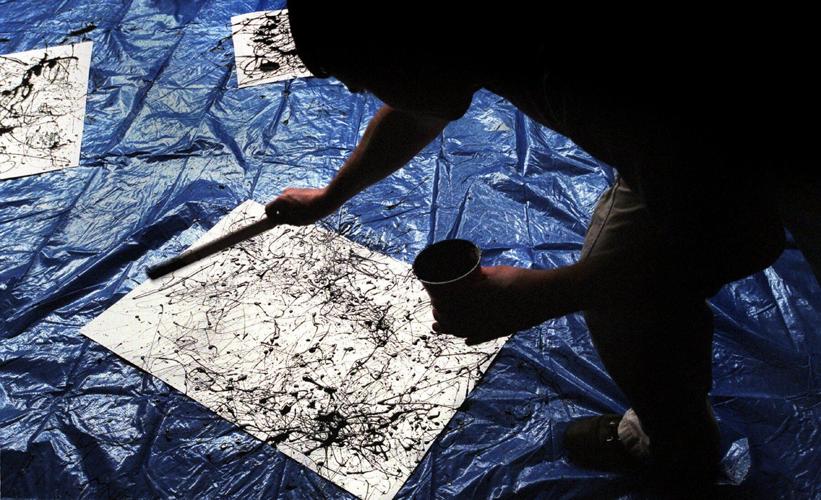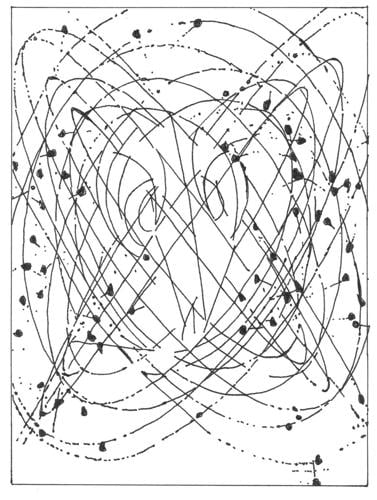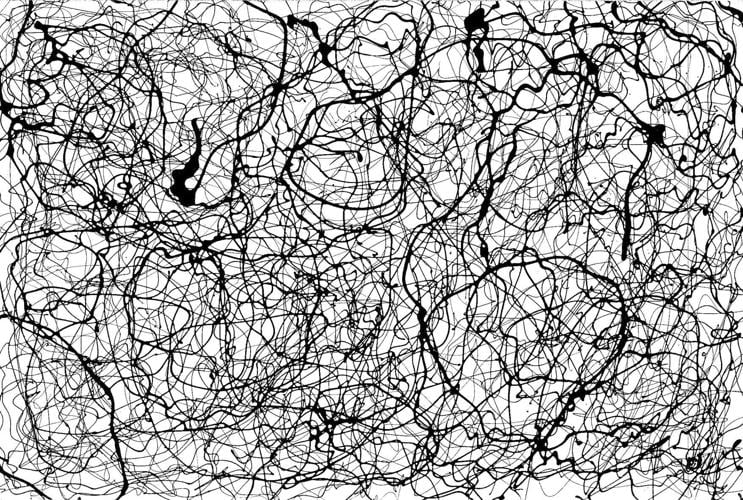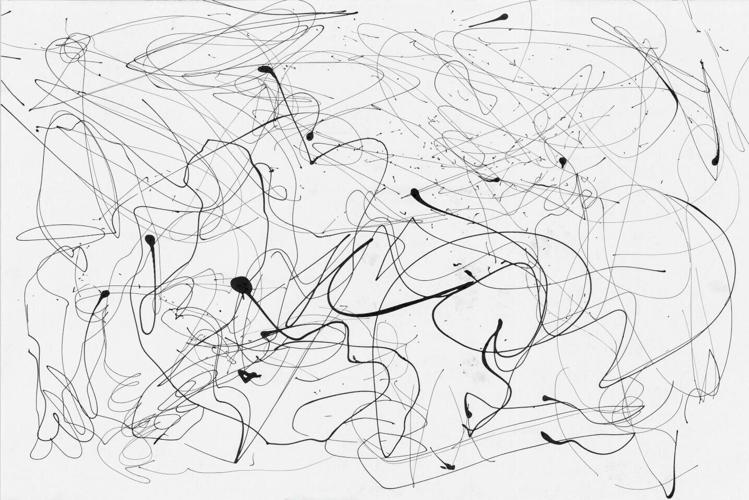
During the 'dripfest' experiment adults and children were asked to recreate a painting in Pollock's style. (Richard Taylor via SWNS)
By Stephen Beech
Children's paintings share key characteristics with famous artworks by expressionists such as Jackson Pollock, according to new research.
Scientists found that adults paint richer, more varied trajectories than children.
But the 20-year study also discovered that well-known works by expressionist painters, including Pollock's pour-painting, have "child-like" characteristics.
American Pollock was a leading figure in the abstract expressionist movement, noted for his "drip technique" of pouring or splashing liquid household paint onto a horizontal surface, before his death in a car crash, aged 44, in 1956.
American researchers set out to discover if we can reliably tell if an artwork has been created by children or adults.
Study senior author Professor Richard Taylor said: “Our study shows that the artistic patterns generated by children are distinguishable from those created by adults when using the pouring technique made famous by Jackson Pollock.

Max Ernst’s ‘Young Man Intrigued by the Flight of a Non-Euclidean Fly.’ (Fairbanks et al via SWNS)
“Remarkably, our findings suggest that children’s paintings bear a closer resemblance to Pollock paintings than those created by adults.”
He explained that "fractals" - patterns that repeat at different scale sizes - are all around us, in trees, clouds, and mountains, but also in many artworks from various cultures.
Fractal dimensions describe the complexity of fractals.
For the new study, published in the journal Frontiers in Physics, the research team used fractal analysis and lacunarity analysis to describe the paintings' characteristics.
Taylor said that fractal analysis measures the scaling behavior of paint distributed in space, while lacunarity focuses on variations in the gaps between paint clusters.
Eighteen children, aged four to six, and 34 adults, aged 18 to 25, were recruited to recreate paintings such as Jackson Pollock’s by splattering diluted paint onto sheets of paper placed on the floor.
Taylor said the age groups were chosen because adults and children are at different stages of their biomechanical balance development, which may influence pouring technique.

Example of pour-painting created by an adult during the Dripfest experiments. (Fairbanks et al via SWNS)
The study started in 2002, was picked up in 2018, and now, the team has reunited to finalize it.
Taylor, from the University of Oregon, said: “We are very happy that after all this time we are finally publishing the results.
"Luckily, they are even more relevant today than 20 years ago.
“The COVID-19 pandemic saw an increase in stress levels across society, and fractals have been shown to be an effective way of reducing stress through their aesthetic impact.”
The analysis showed that adults’ paintings had higher paint densities and wider paint trajectories, which can be understood as a painting’s ‘bones’.
But children's paintings were characterized by smaller fine-scale patterns, and there were more gaps between paint clusters.
They showed simpler, one-dimensional trajectories that changed direction less often compared to the richer, more varied trajectories of adults.
The differences may originate from the artists’ biomechanical balance, according to the research team.

Image of Pollock's Number 14, 1948. (Fairbanks et al via SWNS)
While the current study did not measure balance directly, the researchers say that including motion sensors while artists paint in future studies could confirm that.
The team also plans to apply lacunarity analysis to a broad range of artists in future studies.
Some of the paintings created by adults were also analyzed for perceived complexity, visual interest, and pleasantness.
The results showed that the paintings with more space between and less complex fractal patterns were perceived as more pleasant.
Children’s paintings, although not analyzed for pleasantness, also have those characteristics.
Pleasantness may have to do with familiarity, according to the research team.
So far, studies have focused on a fractal dimension in which the most prevalent fractals in natural scenery can be found.
Taylor said: “Our previous research indicates that our visual systems have become ‘fluent’ in the visual languages of fractals through millions of years of exposure to them in natural scenery.

Example of pour-painting created by a child during the Dripfest experiments. (Fairbanks et al via SWNS)
“This ability to process their visual information triggers an aesthetic response.
"Intriguingly, this means that the children’s poured paintings are more attractive than the adult ones.”
The researchers also analyzed two expressionist works for comparison: Jackson Pollock’s ‘Number 14,’ and Max Ernst’s ‘Young Man Intrigued by the Flight of a Non-Euclidean Fly.’
The team found that Ernst’s fractal dimension values lay within the children’s distribution, which might be because the pendulum he used to paint may have partially suppressed natural body motions.
The values of fractal dimensions found in Pollock’s painting lay within the adult distribution, but just so.
The values came close to the children’s range, which is consistent with Pollock’s limited biomechanical balance, according to the research team.
Taylor added: “Along with Claude Monet’s cataracts, Vincent van Gogh’s psychological challenges, and Willem de Kooning’s Alzheimer’s condition, art historical discussions of Pollock’s limited biomechanical balance serve as a reminder that conditions that present challenges in aspects of our daily lives can lead to magnificent achievements in art."

























(0) comments
Welcome to the discussion.
Log In
Keep it Clean. Please avoid obscene, vulgar, lewd, racist or sexually-oriented language.
PLEASE TURN OFF YOUR CAPS LOCK.
Don't Threaten. Threats of harming another person will not be tolerated.
Be Truthful. Don't knowingly lie about anyone or anything.
Be Nice. No racism, sexism or any sort of -ism that is degrading to another person.
Be Proactive. Use the 'Report' link on each comment to let us know of abusive posts.
Share with Us. We'd love to hear eyewitness accounts, the history behind an article.